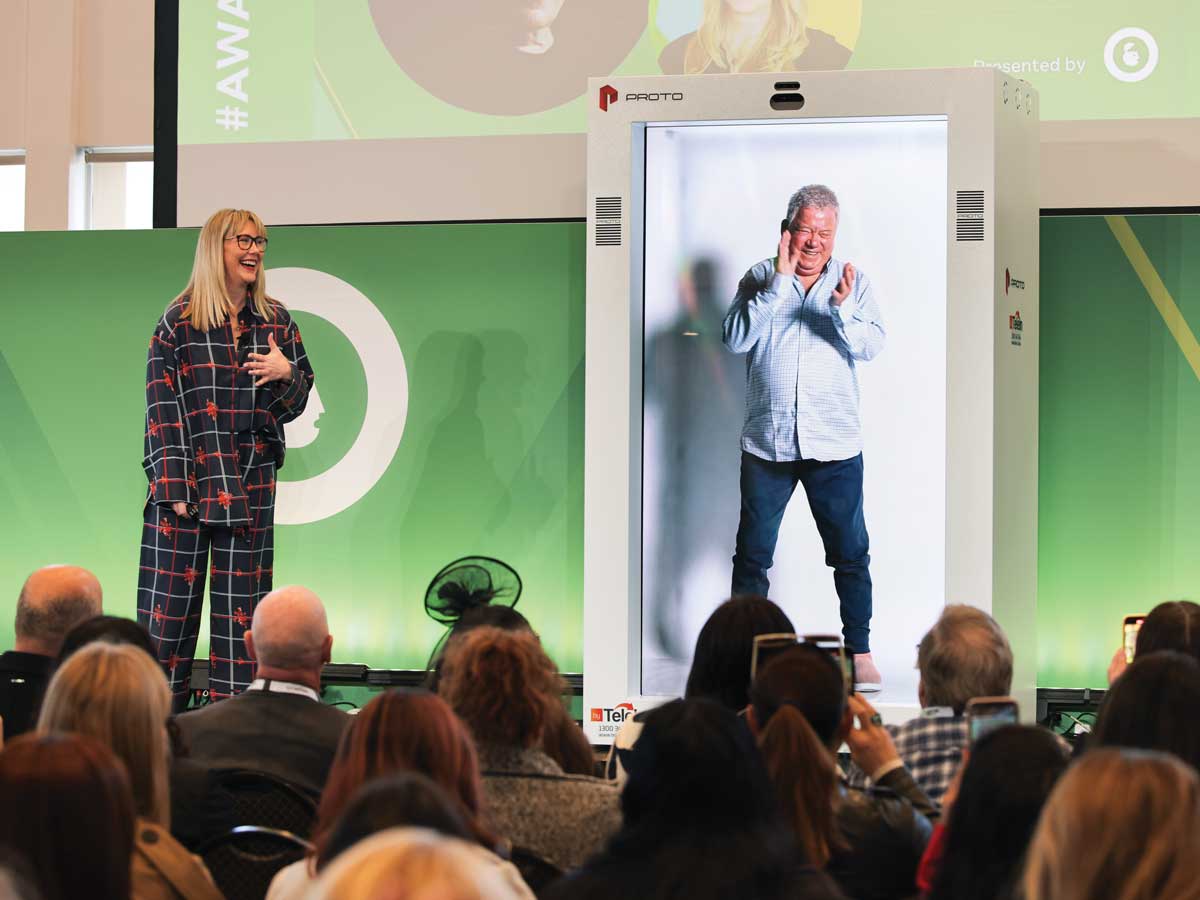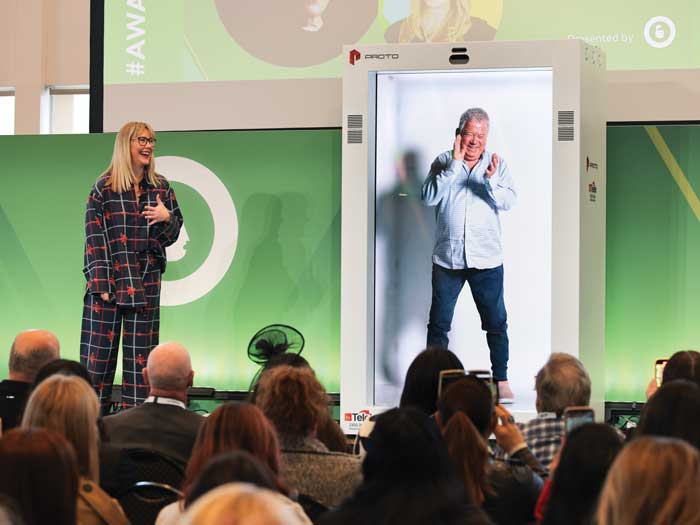
A “Proto”-type for the new storytelling
 Sci-fi star William Shatner beams in from L.A. to Australia via Proto for a keynote (Photograph courtesy of Proto Inc.)
Sci-fi star William Shatner beams in from L.A. to Australia via Proto for a keynote (Photograph courtesy of Proto Inc.)
When Proto Inc. CEO and founder David Nussbaum was young, he dreamed of being a broadcaster. Back then, his goal was telling stories that would be heard around the world—but his love of sharing stories was taken to the next level in 2012, when he watched as the late Tupac Shakur materialized on stage as a hologram at Coachella. “The icon himself was now performing in front of a crowd, people who never could have seen him were seeing him,” he recalls. Intrigued, he tracked down the company behind the Tupac hologram and helped his then employer buy the tech from them. While not based on those patents, Nussbaum invented the new Proto tech because he could see the limitations of the old technology by working with it closely.
For a while, Nussbaum was in the business of bringing back dead performers; he put on concerts with holographic Whitney Houston, Billie Holiday and Jackie Wilson. But the tech required massive structures, lots of human labour and millions of dollars for just one show. Nussbaum knew that he’d have to keep “booking” bigger and bigger acts to make the business sustainable. Instead, he took his love of broadcasting and his new expertise in hologram projection, mashed up the two and created a new company, Proto, in his living room in 2018.
Proto, formerly known as Portl, is a Los Angeles-based company that makes two-way holographic boxes that allow users to see, hear and interact with anyone and anything in the world. The company already has a presence in close to 30 countries. It works similarly to video calling apps like Zoom; users can transmit video content, which appears on life-sized screens. The holographic boxes come equipped with cameras and microphones so audiences can interact in real-time with those broadcasting, and the broadcasters can see and hear their audiences. There are two sizes—one that’s just over seven feet tall, and a table-top version. “Some people have compared it to the Wonka Vision in Willy Wonka,” Nussbaum says.
Proto is used for remote presentation, education and entertainment—the tech has been used to beam teachers to remote areas, presenters to conferences and doctors to patients. Proto has also been used by brands like H&M and Burberry as a way to showcase their products in lieu of mannequins and traditional billboards. It’s even been used by auction houses to show expensive and hard-to-transport items. Nussbaum says users are cutting down on the time, cost and environmental footprint associated with transportation.
Aside from securing Canadian clients and partnerships with companies like Cadillac Fairview, a commercial real estate business, Proto has since developed a Canadian division and distributes the tech north of the 49th parallel, which Nussbaum says has been integral to Proto’s growth.
Plus, Canadian comedian Howie Mandel is now one of Proto’s main investors and brand ambassadors, with the company’s offices even being housed in warehouse space that Mandel owns in Los Angeles. “Howie just slid into my DMs,” Nussbaum says. Since then, Mandel has used Proto to beam into the Just for Laughs comedy festival in Montreal and was also beamed into the Canada Walk of Fame TV ceremony. “When he was shooting America’s Got Talent [in the U.S.], he was also contractually obligated to speak at a Staples event in Toronto, so we beamed him and Heidi Klum to Toronto during commercial break,” Nussbaum says.
Next up, Proto is hoping to expand their operations to more countries and create additional opportunities for audiences and groups to gather in person, even if who they’re seeing is miles away and beaming in.
“Our displays are embedded in movie theatres, airports, car dealerships and hotel lobbies, and we’re also beaming presidential candidates, religious leaders, inspirational speakers and the like onto stages in front of tens of thousands of people,” Nussbaum says, adding that Proto has benefitted from the post-pandemic demand for in-person experiences. “When a person looks like they’re physically there, it creates an emotional connection that only exists when people share the same space at the same time—we’re trying to replicate that.”
More on tech
Check out CPA Canada’s extensive tech resources on everything from robotic process automation to data governance.